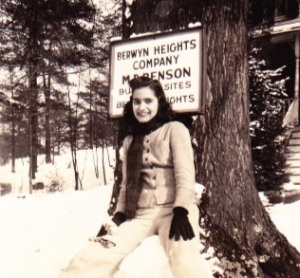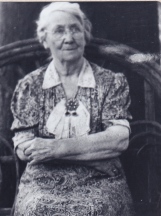AN 1897 ELECTION
In 1976 Don Skarda published the first comprehensive history of Berwyn Heights. Writing about the 1896 incorporation of Berwyn Heights, he said that “the Town charter called for the election of 3 commissioners to serve for one year without pay to administer the affairs of the Town…. Yet for reasons unknown, there is no record that an election of commissioners was ever held or that any other provisions of the charter were ever carried out.” (History of a Small Town, p.21)
If Skarda were writing his history today he probably would have come to a different conclusion. The Internet daily expands our access to all sorts of historic documents and opens new windows on the past. In this case, google books provided access to a source indicating that 3 commissioners were elected in May 1897 and were active for a time, putting into question the widely held belief that the first functioning government of the Town came into being with the election of 1924.
Quoted from Journal of the Proceedings of the Senate of the State of Maryland, p. 892.
“Office of the Secretary of the Senate
March 18th, 1898
The following acts of the General Assembly of Maryland, originating in the Senate, were sealed with the Great Seal, and presented on the 18th day of March, at 11.15 o’clock, A.M., to the Governor of Maryland for approval:
…An Act to declare valid the election of William DeMott, Edwin A. Alger and James C. Brelsford as commissioners of the town of Berwyn Heights, in Prince George’s county, on the first Monday in May, 1897, and to ratify and confirm the acts done by said Commissioners…”
The Act was introduced by William B. Clagett on February 8, 1898, and referred to a Special Committee of Messrs. Clagett, Gray and Bouie. (ibid, p. 220)
Sources: http://www.google.books, History of a Small Town by Don Skarda
Author: Kerstin Harper
BOOKS ONLINE
There are but a few books that deal specifically with the history of Berwyn Heights. Most of them can now be viewed online.
Then & Now: Berwyn Heights, by former Berwyn Heights resident Ann Harris Davidson, published by Arcadia Publishing, 2007
Images of America: College Park by Stephanie Stullich and Katharine Bryant, published by Arcadia Publishing, 2005.
History and Development of the City of College Park, Berwyn Heights, Greenbelt, and Adjacent Areas, from 1745 to 1965, by T. Raymond Burch
THE BERWYN HEIGHTS COMPANY
The Berwyn Heights Company played an important role in the second phase of the Town’s development, lasting from circa 1905 to 1924. BHHC records on the Company are incomplete and leave many questions unanswered. So, any information that adds to our understanding is very welcome.
The Berwyn Heights Building and Improvement Company was incorporated in Washington, D.C. in October 1909 by Fred Benson, Charles Eldridge, William Poultney, William Smyser and Robert Armour for the purpose of developing Berwyn Heights (The Washington Herald, October 23, 1909, Page 11). In the same period, a new streetcar line, the Washington Spa Spring & Gretta Railroad (WSS&GRR) was being constructed to serve the Town. This streetcar company was chartered in 1905 by Samuel S. Yoder, a two term US Congressman from Ohio, who served as its President. Yoder had purchased and was living in the former Waugh mansion on Edmonston Road when Congress was not in session.
Both companies shared the goal to get more people to settle in the town. The streetcar aimed to make it easier to commute to a downtown workplace (the D.C. terminus was at 15th and H Street near the Treasury Department), while the Berwyn Heights Company was advertising and selling land. The Berwyn Heights Company owned land along the tracks but we do not know if there was a formal link between the two ventures or if they operated independently.

Benson home with Berwyn Heights Company sign, 1940
The young lady is a visiting relative from Panama.
Several of the D.C. residents, who incorporated the Berwyn Heights Company, later moved to Berwyn Heights, where they were instrumental in founding the Berwyn Heights (Citizen) Association. Fred Benson served on the board of directors of the Berwyn Heights Company, and by 1920 was presiding over its board while also serving as President of the Association. Elwood Taylor served as vice president, John McNitt as treasurer, and W.H. Willard as secretary.
After Fred Benson’s death in 1923, his wife Margaret Benson and his sons Howard and Clarence appear to have taken on some of the responsibilities for the business. As late as 1943, Margaret and Clarence Benson’s signatures appear on a deed that conveys land in block 27 owned by the Berwyn Heights Company to the Town for the purpose of extending 58th Avenue (formerly Huntley Ave.) from Tecumseh Street (Newby Ave.) to Greenbelt Road.
Author: Kerstin Harper
Sources: Town records, Library of Congress’ digital archive of historic newspapers
THE BENSONS, CONTINUED
After the death of Fred Benson, who led the Berwyn Heights (Citizen) Association from 1915-21, the Benson family remained a significant presence in Berwyn Heights. As stockholders in the Berwyn Heights (Building & Improvement) Company, Margaret and her son Clarence continued to sell lots in Berwyn Heights. Margaret was active in the Berwyn Presbyterian Church and, in 1940, was the first woman to run for the Berwyn Heights Town Council (then functioning as a Board of Commissioners). She fell short by 2 votes.
The eldest son Howard Livingston Benson (1890-1938) worked as a manager for Chase Bank in several locations throughout Central America. In Panama he married Sarah Veysett and they had 5 children. Howard Benson was on the verge of opening his own bank, when his promising career was cut short by the banking crisis of 1933, during which President Franklin Roosevelt closed all banks to stop the run on banks. The children were sent to live with their grandmother in Berwyn Heights and graduated from Hyattsville High School. Howard followed them later. He was elected to the Berwyn Heights Board of Commissioners in May 1938, but died of a heart attack during a hunting and fishing trip in August 1938.
The second son Clarence C. Benson (1891-1951), a 1914 West Point Graduate, had an illustrious career as a U.S. Army cavalry officer and was a pioneer of tank warfare. During World War II, he served as a combat officer in North Africa and the China-India-Burma theatre and, in 1943, was awarded the Silver Star for distinguished service and the Oak Leaf Cluster for gallantry in action.
 Margeret Benson survived her husband and her three children. She died in Berwyn Heights in 1958 at age 90, and is buried at Rock Creek Cemetery, Washington, D.C.
Margeret Benson survived her husband and her three children. She died in Berwyn Heights in 1958 at age 90, and is buried at Rock Creek Cemetery, Washington, D.C.
Author: Kerstin Harper
Sources: James Benson Ancestry.com family tree; Town of Berwyn Heights records
THE BENSONS
In May 2012, the BHHC received an email from James Benson, in Altadena, California. He was interested in information about his great grandmother, Margaret (Maude) Benson, whom he visited in Berwyn Heights as a child in the 1950s. Further correspondence established that the Bensons lived in an American Four Square at 8403 58th Avenue (formerly Huntley Avenue) at the intersection with Goucher Drive. In its early days, the house stood next to the tracks of the electric streetcar line that served Berwyn Heights from 1910 to 1921. Thanks to Mr. Benson sharing information about his family and additional research, a very interesting story emerged.
Margaret and her husband Fred Hodges Benso n moved into town with their three children Howard, Clarence and Margaret Flora sometime between 1910 and 1912. Previously, the family lived in Washington D.C. where Fred Benson worked for the U.S. Treasury Department, Office of the Comptroller of the Currency. In October 1909, Benson and several other investors incorporated the Berwyn Heights Building & Improvement Company (Berwyn Heights Company) for the purpose of developing the Town and attracting new residents. This came at a time when a new electric streetcar, the Washington Spa Spring & Gretta Railroad (WSSGRR), was being built to service the area. The first cars started to run from the corner of 15th and H Street, not far from the Treasury Department, to Bladensburg in 1910, and service was extended to Berwyn Heights in 1912.
n moved into town with their three children Howard, Clarence and Margaret Flora sometime between 1910 and 1912. Previously, the family lived in Washington D.C. where Fred Benson worked for the U.S. Treasury Department, Office of the Comptroller of the Currency. In October 1909, Benson and several other investors incorporated the Berwyn Heights Building & Improvement Company (Berwyn Heights Company) for the purpose of developing the Town and attracting new residents. This came at a time when a new electric streetcar, the Washington Spa Spring & Gretta Railroad (WSSGRR), was being built to service the area. The first cars started to run from the corner of 15th and H Street, not far from the Treasury Department, to Bladensburg in 1910, and service was extended to Berwyn Heights in 1912.
The year 1915 found Fred Benson leading the effort to establish a citizen association in Berwyn Heights. According to the minutes of the association, “on January 28, 1915 at the request of F. H. Benson a number of residents and property owners of Berwyn Heights met at the residence of Mr. Benson and decided to form the Berwyn Heights Association primarily for the betterment of walks and streets and incidentally the general improvement of conditions in which the local community were interested.” Those present voted to elect Fred Benson President of the Association, a position to which he was re-elected every year until 1921 when he suffered a stroke. He continued to serve as honorary President until his death from a 2nd stroke in 1923.
Author: Kerstin Harper
Sources: James Benson’s Ancestry.com family tree; Library of Congress digital archive of historic newspapers; Town of Berwyn Heights’ Minutes of the Berwyn Heights Association
WAUGH AVENUE MARKER II
The Historical Committee during the last year has been discussing plans to redo it’s first street marker, Waugh Avenue, which contains several inaccuracies and mistakes. Readers are invited to comment to improve the next marker:
WAUGH AVENUE MARKER II
James E. Waugh, after whom this street was initially named, was a driving force behind the creation of this community. He was born on July 14, 1841 in Georgetown, D.C. and on February 15, 1858, married Rachel Sarah Victoria McKelden. Waugh began his career as a grocery merchant, worked for a time as a clerk in the Treasury Department, and then went into the real estate and insurance business.
At the onset of the Civil War, Waugh organized a company of volunteers, the Eagle Guards, for the defense of the capital city. He served as First Lieutenant and then as Sergeant under Captain Degges until the unit dissolved in June 1861. Waugh was also a member of the Masonic Order of the Knights Templar, Columbia Commandery No. 2, in which he served as Eminent Commander in 1876, and an honorary member of the National Rifles.
In 1886, Waugh, with Washington businessman David Lamb, began to buy up land east of the B&O Railroad between the Branchville and College Lawn stations to create a new suburban development. In 1888, Waugh and business partners Edward Graves and Benjamin Charlton had the land surveyed and platted under the name of Charlton Heights. In 1889, they incorporated the Charlton Heights Improvement Company (CHIC), which built a score of houses and basic infrastructure and began to sell properties.
Sales in the development were slow and CHIC failed in 1892. Waugh died of a stroke in 1895 in his Charlton Heights home near Edmonston Road.
Author: Kerstin Harper
Sources: BHHC Waugh pamphlet; Don Skarda’s History of a Small Town; Ann Harris Davidson’s Then & Now: Berwyn Heights; Library of Congress digital archive of historic newspapers